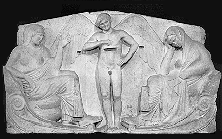| It has been suggested that the winged figure holding the scales on the Boston Throne is Eros, god of love. This would relate it to the Ludovisi Throne's proposed illustration of the birth of Aphrodite and the cults of Locri Epizefiri as Eros was thought, in some myths, to be Aphrodite's son. Eros could be testing love, but there are no other instances of him presiding over such a scene in Greek art. |  |
| If the winged youth is Eros, there is a problem in his representation. It has been suggested that he has more in common with the Roman representation of Eros than the Greek. |
| The winged youth could be Thanatos, the god of death (another Homeric subject). However, he has little iconography in Greek Art, and there are few representations of him to compare the Boston Throne to. On the right is a marble relief column drum from Ephesos, from c. 350 BC ( 100 years after the Ludovisi Throne was probably made.) Thanatos is represented as a youth, similar to the winged youth on the Boston Throne.
However, the winged youth may just be an unknown Daemon from the Underworld, as shown in medieval representations of Psychostasia. He may appear as a small youth because of the compositional restraints caused by the size of the throne. |
 |
| This ambiguity could lead to the Boston Throne's meaning. The young Eros and final Thanatos represent the incompatable apects of divinity, showing mirror images of two big experiences in life- love and death. This could link with the figures on the sides of the throne; youth and old age showing the beginning and ending of intelligent life. Then again, maybe this is a strained reading, and the throne is just a modern fake which has confused imagery. |